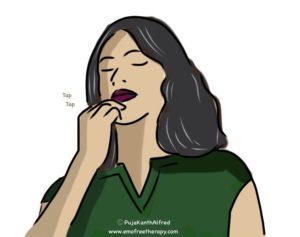I’m sharing a personal example of a recent situation where tapping on anxiety and taking its messages really helped me.

A few weeks ago I enrolled in a meditation course. It was an online event and I was excited to be a part if it. But by the end of the first day I was feeling weird about the class. I couldn’t place my finger on what it was, the only thing that stood out for me was the way the class was conducted which didn’t feel comfortable. I decided to go for the second class so that I could give the class/instructor a benefit of doubt. The second day I felt even worse. I felt that it wasn’t working for me, the teachings, conduct and content felt totally out of sync with my sensibilities.
After the class, I tapped on acknowledging my anxiety and taking the message from it. After tapping, I felt calmer and the message in my anxiety was clear – the class didn’t feel like a safe place to learn, hence I decided to quit the course. I felt relieved and was reminded of many other situations where anxiety literally saved me from getting into a situation that felt totally out of sync with my values and beliefs etc. I think the course was probably beneficial for others but it surely wasn’t my cup of tea, and I wasn’t about to force myself to do something that didn’t sit well with me.
I also became aware that the content of the course was more like spiritual bypassing. It didn’t really gel with my philosophy of seeing things in a context, having a balanced view of the world, honouring all emotions and taking their messages, taking into account our unique contexts and situations with compassion, etc – these are at the heart of my work with my clients.
In short, my anxiety helped me to see things clearly and to align my actions with my beliefs and values.
WHAT IS ANXIETY?
Fear is about sensing danger in the present- the here and now, whereas anxiety is a form of fear of the future.
Worry, bodily sensations and tension are ingredients of anxiety.
HOW CAN TAPPING HELP?
Tapping is very effective for anxiety and while tapping if you can also acknowledge and take the message in anxiety, then it’ll be even more helpful.
Tapping on Anxiety
Here is a step by step process for tapping on mild to medium level of anxiety. This process uses reframes ( looking at anxiety with new perspectives) hence reading this article will help in order to understand what it means to take the messages from your anxiety.
If your anxiety is in an intense state then just tapping through the points and saying anything related to anxiety that comes to your mind, several rounds, will help. Once the anxiety has lessened (within 4-5 range on a scale of 0 to 10), then try this process.
1. Start by Tapping on how your body feels when you’re anxious.
Even though I’m anxious and I feel this heaviness in my chest (the bodily sensations) , I accept myself/acknowledge this anxiety in my body.
Reminder Phrase: this anxiety and this heaviness in my chest
( If there’s no body sensation and it’s only the mind chatter, worry, catastrophic thoughts that create anxiety for you, then tap on, Even though I have so many thoughts running in my head, so many what ifs, I deeply and completely accept myself.)
Tip: Tap on catastrophic thoughts, feelings and body sensations – whatever feels most pressing or prominent for you.
2. Tap on why you’re feeling anxious. You can keep a diary and note when you feel most anxious or at what point your anxiety starts building up. Based on that you’ll have a clue as to what is causing your anxiety every time it comes up.
Even though I’m anxious because I have an upcoming presentation, I deeply and completely accept myself.
Reminder Phrase: this anxiety because….
Even though I’m anxious probably because I’ve been working non-stop, I deeply and completely accept myself
Reminder Phrase: this anxiety because….
Even though I’m anxious because this situation-person doesn’t feel right, I deeply and completely accept myself
Reminder Phrase: this anxiety because….
3. Tackle all the high intensity aspects for the example you’re tapping on.
In EFT, aspects refers to the pieces of a problem, the different parts of a problem. If you’re new to EFT then download this free manual from EFTi to understand the basic process in EFT.
Examples:
Even though I’m anxious about how the presentation will go, I deeply and completely accept myself/I accept how I feel
Reminder Phrase: this anxiety about how the presentation will go
Even though I’m worried that I might be judged by others, I deeply and completely accept myself/I accept how I feel
Reminder Phrase: this worry that I might be judged by others
Even though I’m worried that I might forget what to say, I deeply and completely accept myself/I accept how I feel
Reminder Phrase: this worry that I might forget what to say
4. Taking the message – Tap on what you think your anxiety is trying to convey.
Examples for tapping on taking the message from anxiety:
Even though I still feel anxious, I’m willing to take the message in my anxiety.
Reminder Phrase(s): This remaining anxiety/I’m willing to take the message in it
Even though I’m still anxious, I acknowledge that I feel anxious because I haven’t finished these pending tasks and maybe it’s time to start working on them.
Reminder Phrase(s): this remaining anxiety/I acknowledge that…
Even though I feel anxious, it seems like I’m going too fast, I deeply and completely love and accept myself. And maybe I need to slow down.
Reminder Phrase(s): It looks like I’m going too fast/Maybe I need to slow down
Even though I feel anxious and it seems my anxiety is telling me that this situation isn’t working for me and that I don’t have to push through this, or force myself to stay in this situation, I deeply and completely love and accept myself.
Reminder Phrase(s): this anxiety seems to tell me that ….
Let me know how the process goes for you.
If you have chronic anxiety, then working with a tapping buddy or EFT Practitioner will help.





 s that not only do we need to cope with stress in a healthy manner but also actively
s that not only do we need to cope with stress in a healthy manner but also actively  will still put the chair back in its place 😅, I do so without any irritation.
will still put the chair back in its place 😅, I do so without any irritation.


